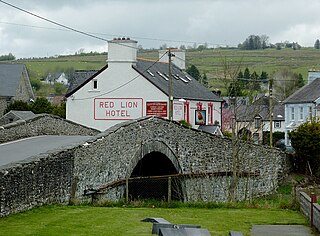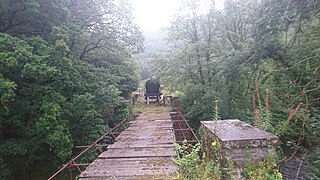Banknotes of the Black Sheep Company of Wales Limited were private sterling banknotes issued between June 1969 and 1972 by the Welsh banker Richard Hugh Williams of Llandudno, Wales. The notes were a private issue by Williams's private banking venture, and each issue had to be approved by the Board of Trade. [1] Although not official legal tender in Wales, they would have enjoyed a similar status to Scottish and Northern Irish banknotes as promissory notes.
In March 1969 Richard issued notes called Banknotes of the Chief Treasury of Wales Limited. These continued to be issued until June 1969. The Board of Trade was uncomfortable with his use of the Welsh word for "treasury" in the name of his company - Prif Trysorfa Cymru Ltd ('Chief Treasury of Wales Ltd'), as it appeared to confer upon his endeavour the functions of state. The Board therefore imposed numerous restrictions on the denominations permitted, and refused to approve notes below the value of £5. [1] The last issue of the Chief Treasury of Wales Ltd was a £1 million pound note. [1]
Williams was forced to change the name of his company in 1969 and he selected Cwmni y Ddafad Ddu Gymreig Cyfyngedig ("Welsh Black Sheep Company Limited"), [1] recalling the banknotes which had been issued in the early 19th century by the Aberystwyth and Tregaron Bank and which featured an picture of black sheep. [2]
The earliest issues contained a phrase in Welsh that referred to the Chief Treasury of Wales Limited, so that anyone who had the old notes knew who would exchange them for new notes. The phrase in question is "Gynt, Prif Trysorfa Cymru Cyfyngedig", the company thus describing itself as "formerly, Chief Treasury of Wales Ltd".
Williams had to send his banknotes to the Inland Revenue at Somerset House prior to issue; according to the law of the time, promissory notes each attracted a stamp duty payment by Williams of 2d, and notes were stamped with a "two pence" duty stamp. The Board of Trade imposed numerous restrictions on the denominations permitted, Williams's use of the term "£G" (meaning "Welsh pound", suggesting a separate currency) and his use of the Prince of Wales's feathers in the designs. [1]
This issue was released into circulation as from the 15 February 1971. Williams ceased production of the notes and he was eventually declared bankrupt by Bangor Crown Court in 1978. [1] [3]

A banknote—also called a bill, paper money, or simply a note—is a type of negotiable promissory note, made by a bank or other licensed authority, payable to the bearer on demand. Banknotes were originally issued by commercial banks, which were legally required to redeem the notes for legal tender when presented to the chief cashier of the originating bank. These commercial banknotes only traded at face value in the market served by the issuing bank. Commercial banknotes have primarily been replaced by national banknotes issued by central banks or monetary authorities.

The pound sterling is the official currency of the United Kingdom, Jersey, Guernsey, the Isle of Man, British Antarctic Territory, South Georgia and the South Sandwich Islands, and Tristan da Cunha.

Tregaron is an ancient market town in Ceredigion, Wales. It is sited astride the River Brenig, a tributary of the River Teifi, and is 11 miles (18 km) north-east of Lampeter. According to the 2011 Census, the population of the ward of Tregaron was 1,213 and 67% of the population could speak Welsh; Tregaron is a community covering 33 square miles (85 km2); two-thirds of the population were born in Wales.

Pontrhydfendigaid is a village in Ceredigion, Wales. It lies on the western flank of the Cambrian Mountains, between Devil's Bridge and Tregaron. The village lies on the River Teifi, whose source is just 3 miles (5 km) to the east at Llyn Teifi. The community of Ystrad Fflur, which Pontrhydfendigaid makes most of the population of, had a population of 712 as of 2011 census.
De La Rue plc is a British company headquartered in Basingstoke, England, that produces secure digital and physical protections for goods, trade, and identities in 140 countries. It sells to governments, central banks, and businesses. Its Authentication division provides Government revenue technology, brand protection, and ID security, such as polycarbonate data pages for passports. Its Currency division designs and produces banknotes, secure polymer substrate and banknote security features. This includes security holograms, security threads and security printed products for central banks and currency issuing authorities. It is listed on the London Stock Exchange. It is the world's largest commercial printer of banknotes.
The Irish Free State, subsequently known as Ireland, resolved in the mid-1920s to design its own coins and banknotes. Upon issuing the new currency, the Free State government pegged its value to the pound sterling. The Currency Act, 1927 was passed as a basis for creating banknotes and the "Saorstát pound" as the "standard unit of value." The legal tender notes issued under this act began circulating on 10 September 1928.
Commonwealth banknote-issuing institutions also British Empire Paper Currency Issuers comprises a list of public, private, state-owned banks and other government bodies and Currency Boards who issued legal tender: banknotes.

Waterlow and Sons Limited was a major worldwide engraver of currency, postage stamps, stocks and bond certificates based in London, Watford and Dunstable in England. The company was founded as a family business in 1810. It was acquired in 1961 by De La Rue.

The Carmarthen–Aberystwyth line was originally a standard-gauge branch line of the Great Western Railway (GWR) in Wales, connecting Carmarthen and Aberystwyth.

The Royal Bank of Scotland is a major retail and commercial bank in Scotland. It is one of the retail banking subsidiaries of NatWest Group, together with NatWest and Ulster Bank. The Royal Bank of Scotland has around 700 branches, mainly in Scotland, though there are branches in many larger towns and cities throughout England and Wales. The bank is completely separate from the fellow Edinburgh-based bank, the Bank of Scotland, which pre-dates the Royal Bank by 32 years. The Royal Bank of Scotland was established to provide a bank with strong Hanoverian and Whig ties.

Sir Thomas Herbert Parry-Williams was a Welsh poet, author and academic.

The Bank of England, which is now the central bank of the United Kingdom, British Crown Dependencies and British Overseas Territories, has issued banknotes since 1694. In 1921 the Bank of England gained a legal monopoly on the issue of banknotes in England and Wales, a process that started with the Bank Charter Act of 1844 when the ability of other banks to issue notes was restricted.

Birdland Park and Gardens, often called Birdland, is a wildlife park in Bourton-on-the-Water, Gloucestershire, England. First opened in 1957, the park moved to its current site in 1989. Birdland began in the 5-acre (2.0 ha) grounds of a Tudor manor house called Chardwar and was started by Len Hill, who was often referred to as the Penguin Millionaire.
The bank officially known as the Aberystwith and Tregaron Bank was established at Aberystwyth, Cardiganshire in the beginning of the 19th century and was locally known as ‘Banc y Ddafad Ddu’, because the bank notes were imprinted with an engraving of a black sheep. The bank later established a branch at Tregaron.

Northern Bank Limited is a retail bank in Northern Ireland. Northern Banking Company Limited was formed from a private bank, with the Deed of Partnership being signed on 1 August 1824. It is one of the oldest banks in Ireland with its private banking history dating back to 1809, and forms part of one of the Big Four banks in Ireland. Northern Bank took on the name of its parent company Danske Bank as its trading name in November 2012. It is a leading bank in Northern Ireland and a growing bank in Great Britain. In Northern Ireland, the Bank issues its own banknotes.
Robert Joseph Davies, of Cwrtmawr, Llangeitho was a leading figure in the political and religious life of Cardiganshire and in the Calvinistic Methodist denomination. He was the father of John Humphreys Davies.

Banknotes of the Australian pound were first issued by numerous private banks in Australia, starting with the Bank of New South Wales in 1817. Acceptance of private bank notes was not made compulsory by legal tender laws but they were widely used and accepted. The Queensland government issued treasury notes (1866–1869) and banknotes (1893–1910), which were legal tender in Queensland. The New South Wales government issued a limited series of Treasury Notes in 1893.
The coast of Ceredigion is made up of a long coastal plain that contains high cliffs, coves, large bays and estuaries. The coastal plain gets narrower towards the more mountainous north of the county and is cut by the wide estuaries of the Teifi and the Dyfi. The broad and fertile Teifi valley is ideal for dairy farming and mixed farming. Heavy rainfall washes the minerals out of the soil and results in the mountainous areas of the county having relatively poorer, acidic soils. The plough line can be as low as 700 feet, which restricts cultivation.
The North and South Wales Bank was formed in Liverpool in 1836 and was originally located in premises in James Street, Liverpool.

The 2022 Ceredigion County Council election took place as of 5 May 2022 to elect 38 members to Ceredigion Council. On the same day, elections were held to the other 21 local authorities and to community councils in Wales as part of the 2022 Welsh local elections. The previous all-council election took place in May 2017 and future elections will take place every five years.